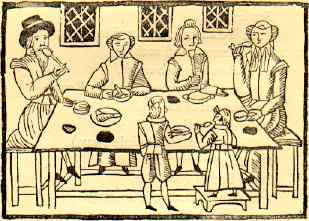Shakespeare's family
John Shakespeare
Although there are no other records about the young Shakespeare during this period, there is a fair amount of information about his father, a glove-maker who also held a number of public offices over a twenty year period, ranging from borough ale-taster to alderman to bailiff, the highest public office in Stratford. Stratford was a market center for the county of Warwickshire in the rural heartland of England.
From about 1577, when William was 13, John Shakespeare suffered financial loss* and ceased to play a part in local government. His situation improved* from 1596 until his death in 1601.
Mary Shakespeare (nee Arden)
Shakespeare's mother was born Mary Arden, the daughter of a well-to-do landowner in a lesser branch of an aristocratic family. (The family gave its name to the nearby Forest of Arden, which is the setting of Shakespeare's As You Like It.)
It is typical of the period that, though many references to John Shakespeare's activities survive, only the date of Mary Shakespeare's burial (9 September 1608) was recorded.
Shakespeare's brothers and sisters
- Joan, born 1558, died before 1569.
- Margaret, born 1562, died 1563 (aged 5 months).
- (William, born 1564, died 1616.)
- Gilbert, born 1566, haberdasher, died 1612. (A haberdasher sells hats, clothes, thread, ribbons etc.)
- Joan*, born 1569, married William Hart, died 1646.
- Anne, born 1571, died 1579.
- Richard, born 1574, occupation unknown, died 1613.
- Edmund,* born 1580, "player," died 1607.
Footnotes
-
Financial difficulties
In 1575 John Shakespeare was wealthy enough to buy two houses, but in 1577 he stopped attending council meetings, though he was an alderman. The following year he mortgaged a property of his wife's and sold her share in another. Later, he faced various fines and lost his aldermanic seat. In 1592 he was listed among those who failed to attend church, "for feare of process for debtte."
-
William to the the rescue?
In 1596 John Shakespeare applied for, and was granted, a coat of arms, which would then make him and his family members of the gentry; in 1597 William bought the splendid house New Place on the main street of Stratford. It seems likely that William's undoubted success as shareholder in the Lord Chamberlain's Men (his company of actors) allowed him to restore his father's fortunes.
-
Joan Shakespeare's inheritance
William left his younger sister:
"All my wearing Apparell. . . and the house with th'appurtenances in Stratford wherein she dwelleth."
-
Edmund's burial
Four months after his son's death in 1607, Edmund Shakespeare was buried in Southwark, near the Globe theatre. Of his life and death, David J. Kathman writes:
Edmund Shakespeare was born in Stratford in 1580. The next mention of him which survives is the baptism of his son Edward at St. Leonard's, Shoreditch, on July 12, 1607; however, this son was buried at St. Giles' Cripplegate exactly a month later, on August 12, 1607. The burial record indicates that the infant was "base borne." The baptismal record indicates that Edmund and/or his son came from "morefilds," e.g. Moorfields, the location of the Curtain theater, where Queen Anne's Company was acting in 1607. However, the burial in St. Giles Cripplegate points to the Fortune theater and Prince Henry's Men. Edmund may have acted with one of these companies, or he could have been a hired man who played for both. Then again, it is also possible that he played with neither. Edmund himself followed his son to the grave a scant four and a half months later and was buried in St. Saviour's Southwark, the parish of the Globe theater, on December 31, 1607. This was probably due to the influence of his brother William, a possibility which is strengthened by the fact that Edmund was buried in the church (as opposed to the churchyard) and his funeral featured a forenoon knell of the great bell (as opposed to the lesser bell). Edmund's funeral cost 20 shillings, whereas burial in the churchyard with a knell of the lesser bell only cost 3 shillings, the difference doubtless being paid by William.
(Shaksper listserv, May 1998)
